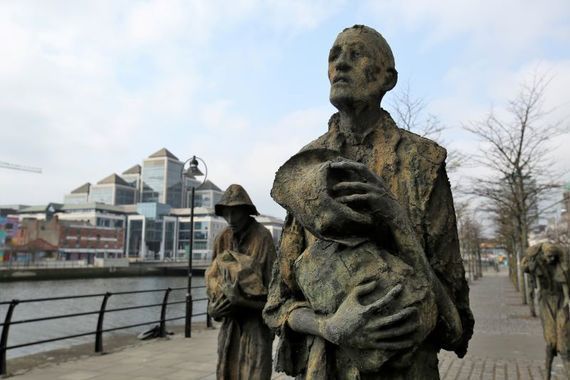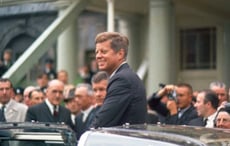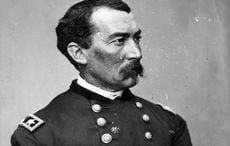The Turkish treatment of Armenians during the First World War was genocide President Joe Biden has stated, in a deeply significant act.
The murder, rape, starvation, torture, and deaths of 1.5 million Armenians by the Turks was always a clear example of genocide and it is heartening to note it was an Irish-American president that finally reached for the truth.
Over one-and-a-half million Armenian families, many just children or elderly and sick were sent on death marches into the Syrian desert where they were left to die in 1915 and 1916.
The definition of the Armenian massacres as genocide should have come long before this but realpolitik and the obsession of the Turkish government with it not being called genocide stayed the hands of every American president up to Biden.
A movie ‘The Promise’ directed by Irish Oscar-winning director Terry George based around the massacre was the subject of a massive effort by Turkish agents to stop widespread distribution and limit the damage the movie created.
Of course, now that the Turkish killings are officially genocide where does that leave the Irish famine where an estimated 15,000 people a day were dying of starvation while the British were evicting them and exporting their food?
Author Thomas Gallagher in “Paddy’s Lament, “ states that during the first winter of famine, 1846-47, as 400,000 Irish peasants starved,” landlords exported 17 million pounds sterling worth of grain, cattle, pigs, flour, eggs, and poultry—food that could have prevented those deaths.
In fairness, Tony Blair’s heartfelt apology in 2011 and acceptance of British perfidy went a long way, but author Tim Pat Coogan in his 2012 book “The Famine Plot” is perfectly prepared to call the Famine genocide. The most significant section of Coogan’s book on the Irish Famine is not his own writing, but his printing of the United Nations definition of genocide.
“In the present Convention, genocide means any of the following acts committed with intent to destroy, in whole or in part, a national, ethnical, racial or religious group, as such:
Killing members of the group;
Causing serious bodily or mental harm to members of the group;
Deliberately inflicting on the group conditions of life calculated to bring about its physical destruction in whole or in part;
Imposing measures intended to prevent births within the group;
Forcibly transferring children of the group to another group.
“The Famine Plot,” published by Palgrave MacMillan, was released in America in 2012 and Coogan should have been here to launch it that November, but in a separate and equally confounding plot, he was denied a visa to come here by the American Embassy in Dublin.
The conclusion from his book, however, is unmistakable.
Ireland’s most prominent historian, who has previously created definitive portraits of both Michael Collins and Eamon De Valera, pointed the finger squarely at the British during the Famine and stated it was genocide.
It is a big charge, but Coogan is a big man, physically, intellectually, and in every sense. This makes it a very effective accusation. Coogan has painted a portrait of devastating neglect, abuse, and mismanagement that certainly fits the genocide concept.
I mean, if we go back to that time, Ireland was the equivalent of Puerto Rico or Samoa, massive dependencies on the United States today.
If there was a massive food shortage in either of those two countries, we would hope that the US would step up to the plate, literally, although President Trump's response in the wake of Hurricane Maria in 2017 was far from upstanding, claiming that the island was to blame for its ongoing humanitarian crisis following the natural disaster.
Back in Famine time, the same potato crop disease occurred most heavily outside Ireland in Scotland, yet there were relatively few casualties as the landowners and government ensured, for their own sakes as much as anything, that there was no mass death.
That was not the case in Ireland, where a very different mentality prevailed. The damned Irish were going to get what they deserved because of their attachment to Catholicism and Irish ways when they were refusing to toe the British line.
As Coogan painstakingly recounts, every possible effort by local organizations to feed the starving was thwarted and frustrated by a British government intent on teaching the Irish a lesson and forcing market forces on them.
Charles Trevelyan was the worst of them all.
Trevelyan, the key figure in the British government, had foreshadowed the deadly policy in a letter to the “Morning Post” after a trip to Ireland, where he heartily agreed with the sentiment that there were at least a million or two people too many in the benighted land and that the eight million could not possibly survive there.
“Protestant and Catholic will freely fall and the land will be for the survivors.”
Shortly after, he was in charge of a policy that brought that situation about.
One Trevelyan story and one quote suffice:
“British Coastguard Inspector-General, Sir James Dombrain, when he saw starving paupers, ordered his subordinates to give free food handouts. For his attempts to feed the starving, Dombrain was publicly rebuked by Trevelyan…”
The Trevelyan quote is, “The real evil with which we have to contend is not the physical evil of the Famine but the moral evil of the selfish, perverse and turbulent character of the people.”
Tim Pat Coogan has done an enormous service with this book.




Comments